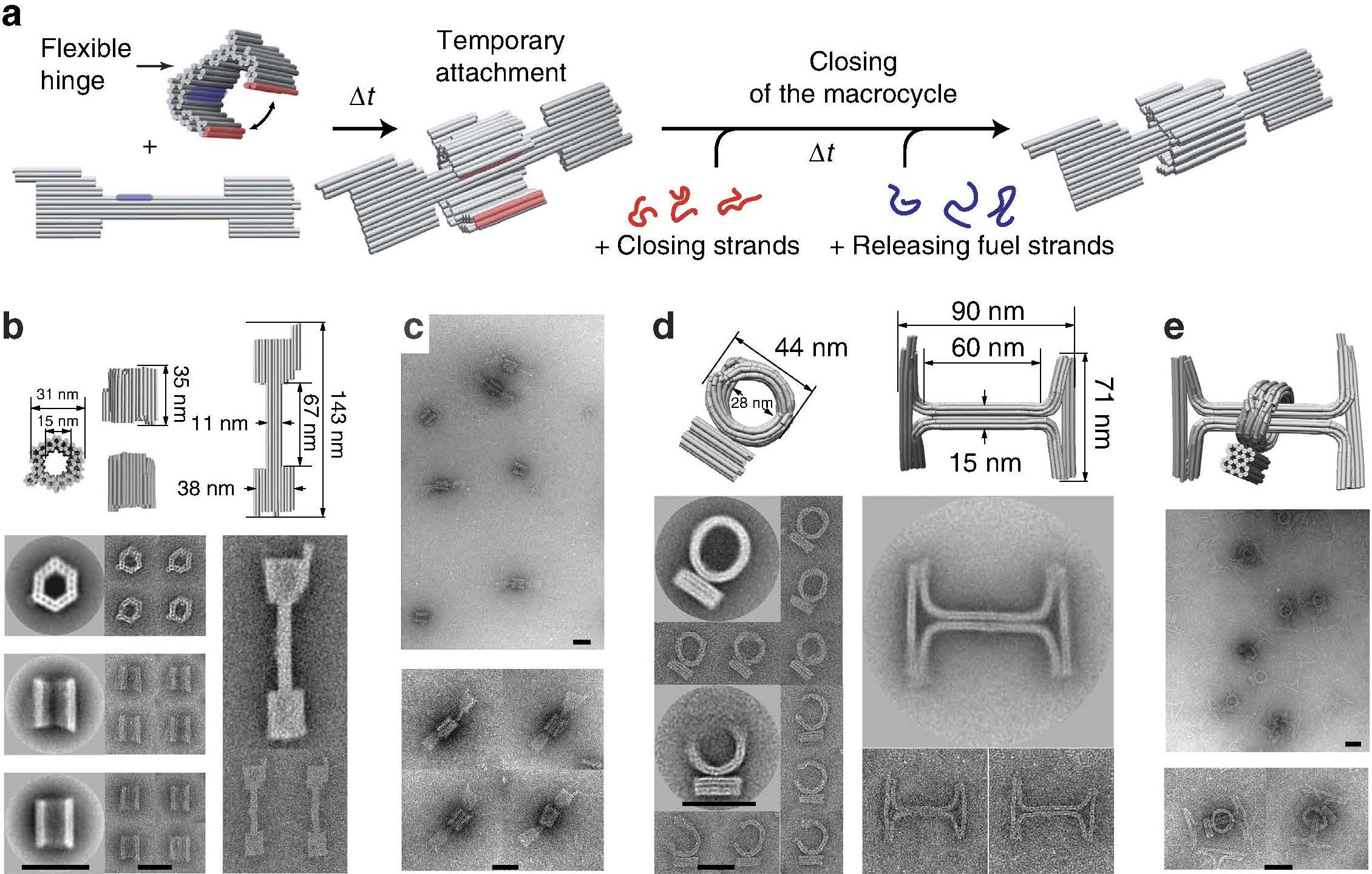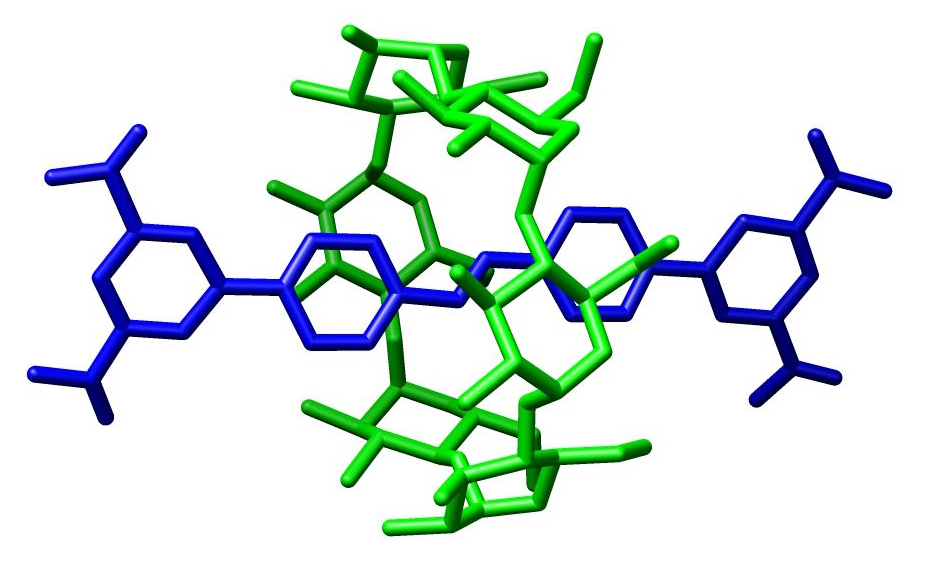Rotaxane cartoon.jpg on:
[Wikipedia]
[Google]
[Amazon]
 In
In


 In
In chemistry
Chemistry is the science, scientific study of the properties and behavior of matter. It is a natural science that covers the Chemical element, elements that make up matter to the chemical compound, compounds made of atoms, molecules and ions ...
, a rotaxane () is a mechanically interlocked molecular architecture
In chemistry, mechanically-interlocked molecular architectures (MIMAs) are molecules that are connected as a consequence of their topology (chemistry), topology. This connection of molecules is analogous to keys on a keychain loop. The keys are n ...
consisting of a dumbbell-shaped molecule which is threaded through a macrocycle (see graphical representation). The two components of a rotaxane are kinetically trapped since the ends of the dumbbell (often called ''stoppers'') are larger than the internal diameter of the ring and prevent dissociation (unthreading) of the components since this would require significant distortion of the covalent bond
A covalent bond is a chemical bond that involves the sharing of electrons to form electron pairs between atoms. These electron pairs are known as shared pairs or bonding pairs. The stable balance of attractive and repulsive forces between atoms ...
s.
Much of the research concerning rotaxanes and other mechanically interlocked molecular architectures, such as catenanes, has been focused on their efficient synthesis
Synthesis or synthesize may refer to:
Science Chemistry and biochemistry
*Chemical synthesis, the execution of chemical reactions to form a more complex molecule from chemical precursors
** Organic synthesis, the chemical synthesis of organ ...
or their utilization as artificial molecular machine
A molecular machine, nanite, or nanomachine is a molecular component that produces quasi-mechanical movements (output) in response to specific stimuli (input). In cellular biology, macromolecular machines frequently perform tasks essential for l ...
s. However, examples of rotaxane substructure have been found in naturally occurring peptides
Peptides (, ) are short chains of amino acids linked by peptide bonds. Long chains of amino acids are called proteins. Chains of fewer than twenty amino acids are called oligopeptides, and include dipeptides, tripeptides, and tetrapeptides.
A p ...
, including: cystine knot peptides, cyclotides or lasso-peptides such as microcin J25.
Synthesis
The earliest reported synthesis of a rotaxane in 1967 relied on thestatistical probability
Frequentist probability or frequentism is an interpretation of probability; it defines an event's probability as the limit of its relative frequency in many trials (the long-run probability). Probabilities can be found (in principle) by a repea ...
that if two halves of a dumbbell-shaped molecule were reacted in the presence of a macrocycle that some small percentage would connect through the ring. To obtain a reasonable quantity of rotaxane, the macrocycle was attached to a solid-phase support and treated with both halves of the dumbbell 70 times and then severed from the support to give a 6% yield. However, the synthesis of rotaxanes has advanced significantly and efficient yields can be obtained by preorganizing the components utilizing hydrogen bond
In chemistry, a hydrogen bond (or H-bond) is a primarily electrostatic force of attraction between a hydrogen (H) atom which is covalently bound to a more electronegative "donor" atom or group (Dn), and another electronegative atom bearing a ...
ing, metal coordination, hydrophobic forces, covalent bond
A covalent bond is a chemical bond that involves the sharing of electrons to form electron pairs between atoms. These electron pairs are known as shared pairs or bonding pairs. The stable balance of attractive and repulsive forces between atoms ...
s, or coulombic interactions. The three most common strategies to synthesize rotaxane are "capping", "clipping", and "slipping", though others do exist. Recently, Leigh and co-workers described a new pathway to mechanically interlocked architectures involving a transition-metal center that can catalyse a reaction through the cavity of a macrocycle.

Capping
Synthesis via the capping method relies strongly upon a thermodynamically driven template effect; that is, the "thread" is held within the "macrocycle" by non-covalent interactions, for example rotaxinations with cyclodextrin macrocycles involve exploitation of the hydrophobic effect. This dynamic complex or pseudorotaxane is then converted to the rotaxane by reacting the ends of the threaded guest with large groups, preventing disassociation.Clipping
The clipping method is similar to the capping reaction except that in this case the dumbbell shaped molecule is complete and is bound to a partial macrocycle. The partial macrocycle then undergoes a ring closing reaction around the dumbbell-shaped molecule, forming the rotaxane.Slipping
The method of slipping is one which exploits the thermodynamic stability of the rotaxane. If the end groups of the dumbbell are an appropriate size it will be able to reversibly thread through the macrocycle at higher temperatures. By cooling the dynamic complex, it becomes kinetically trapped as a rotaxane at the lower temperature."Active template" methodology
Leigh and co-workers recently began to explore a strategy in which template ions could also play an active role in promoting the crucial final covalent bond forming reaction that captures the interlocked structure (i.e., the metal has a dual function, acting as a template for entwining the precursors and catalyzing covalent bond formation between the reactants).Potential applications

Molecular machines
Rotaxane-based molecular machines have been of initial interest for their potential use in molecular electronics as logic molecular switching elements and as molecular shuttles. These molecular machines are usually based on the movement of the macrocycle on the dumbbell. The macrocycle can rotate around the axis of the dumbbell like a wheel and axle or it can slide along its axis from one site to another. Controlling the position of the macrocycle allows the rotaxane to function as a molecular switch, with each possible location of the macrocycle corresponding to a different state. These rotaxane machines can be manipulated both by chemical and photochemical inputs. Rotaxane based systems have also been shown to function as molecular muscles. In 2009, there was a report of a "domino effect" from one extremity to the other in a Glycorotaxane Molecular Machine. In this case, the 4''C''1 or 1''C''4 chair-like conformation of the mannopyranoside Pyranose is a collective term for saccharides that have a chemical structure that includes a six-membered ring consisting of five carbon atoms and one oxygen atom. There may be other carbons external to the ring. The name derives from its similarity ...
stopper can be controlled, depending on the localization of the macrocycle. In 2012, unique pseudo-macrocycles consisting of double-lasso molecular machines (also called rotamacrocycles) were reported in Chem. Sci. These structures can be tightened or loosened depending on pH. A controllable jump rope movement was also observed in these new molecular machines.
Ultrastable dyes
Potential application as long-lasting dyes is based on the enhanced stability of the inner portion of the dumbbell-shaped molecule. Studies with cyclodextrin-protected rotaxaneazo dye
Azo dyes are organic compounds bearing the functional group R−N=N−R′, in which R and R′ are usually aryl and substituted aryl groups. They are a commercially important family of azo compounds, i.e. compounds containing the C-N=N ...
s established this characteristic. More reactive squaraine dye
Squaraine dyes are a class of organic dyes showing intense fluorescence, typically in the red and near infrared region (absorption maxima are found between 630 and 670 nm and their emission maxima are between 650–700 nm). They are char ...
s have also been shown to have enhanced stability by preventing nucleophilic attack of the inner squaraine moiety
Moiety may refer to:
Chemistry
* Moiety (chemistry), a part or functional group of a molecule
** Moiety conservation, conservation of a subgroup in a chemical species
Anthropology
* Moiety (kinship), either of two groups into which a society is ...
. The enhanced stability of rotaxane dyes is attributed to the insulating effect of the macrocycle, which is able to block interactions with other molecules.
Nanorecording
In a nanorecording application, a certain rotaxane is deposited as aLangmuir–Blodgett film
A Langmuir–Blodgett (LB) film is a nanostructured system formed when Langmuir films—or Langmuir monolayers (LM)—are transferred from the liquid-gas interface to solid supports during the vertical passage of the support through the monolayers ...
on ITO-coated glass. When a positive voltage is applied with the tip of a scanning tunneling microscope probe, the rotaxane rings in the tip area switch to a different part of the dumbbell and the resulting new conformation makes the molecules stick out 0.3 nanometer
330px, Different lengths as in respect to the molecular scale.
The nanometre (international spelling as used by the International Bureau of Weights and Measures; SI symbol: nm) or nanometer (American and British English spelling differences#-re ...
from the surface. This height difference is sufficient for a memory dot
Memory is the faculty of the mind by which data or information is encoded, stored, and retrieved when needed. It is the retention of information over time for the purpose of influencing future action. If past events could not be remembered, ...
. It is not yet known how to erase such a nanorecording film.
Nomenclature
Accepted nomenclature is to designate the number of components of the rotaxane in brackets as a prefix. Therefore, the a rotaxane consisting of a single dumbbell-shaped axial molecule with a single macrocycle around its shaft is called a otaxane, and two cyanostar molecules around the central phosphate group of dialkylphosphate is a otaxane.See also
* Catenane *Mechanically interlocked molecular architecture
In chemistry, mechanically-interlocked molecular architectures (MIMAs) are molecules that are connected as a consequence of their topology (chemistry), topology. This connection of molecules is analogous to keys on a keychain loop. The keys are n ...
* Molecular Borromean rings
*Molecular knots
In chemistry, a molecular knot is a mechanically interlocked molecular architecture that is analogous to a macroscopic knot. Naturally-forming molecular knots are found in organic molecules like DNA, RNA, and proteins. It is not certain that ...
*Polyrotaxane
Polyrotaxane is a type of mechanically interlocked molecule consisting of strings and rings, in which multiple rings are threaded onto a molecular axle and prevented from dethreading by two bulky end groups. As oligomeric or polymeric species of ro ...
References
{{reflist, 30em Supramolecular chemistry Molecular electronics Nanoelectronics Organic semiconductors Molecular topology Articles containing video clips